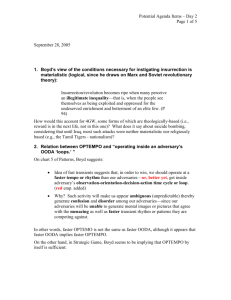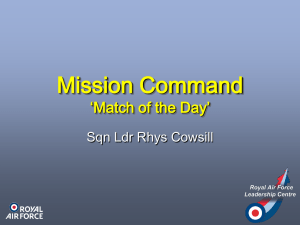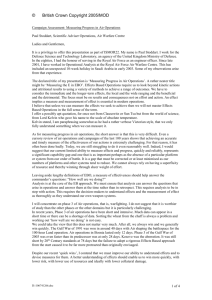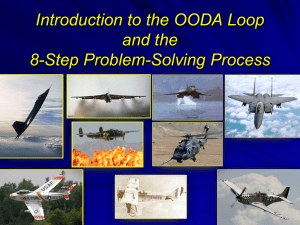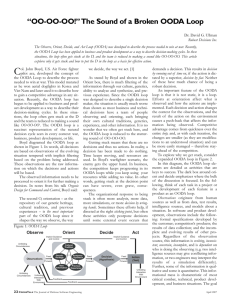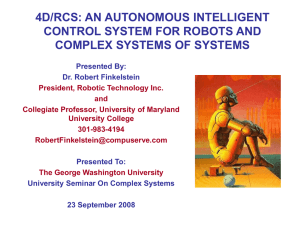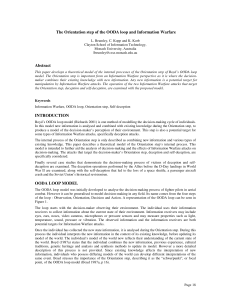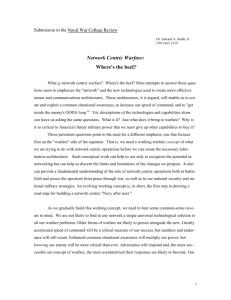Abstract
advertisement
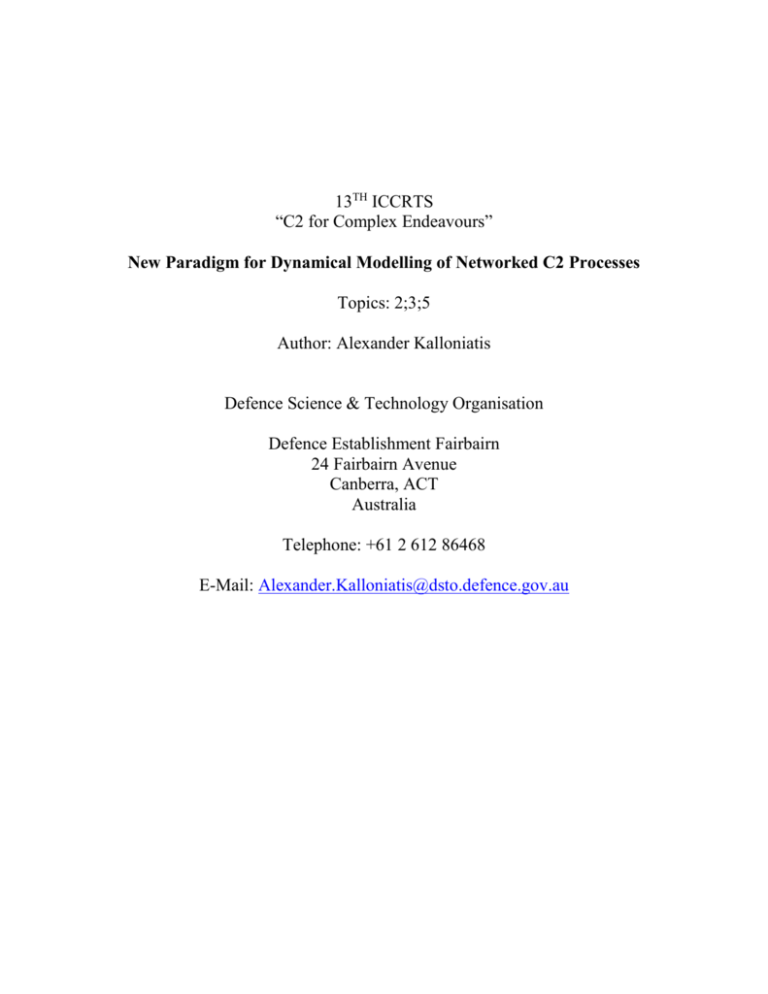
13TH ICCRTS “C2 for Complex Endeavours” New Paradigm for Dynamical Modelling of Networked C2 Processes Topics: 2;3;5 Author: Alexander Kalloniatis Defence Science & Technology Organisation Defence Establishment Fairbairn 24 Fairbairn Avenue Canberra, ACT Australia Telephone: +61 2 612 86468 E-Mail: Alexander.Kalloniatis@dsto.defence.gov.au New Paradigm for Dynamical Modelling of Networked C2 Processes Alexander Kalloniatis Abstract A new type of mathematical model for interacting C2 processes across complex networks is proposed. The approach surrenders the requirement to distinguish the various objects of individual C2 processes (planning, execution of strategic, campaign or tactical activities), but does distinguish the time-scales of and interactions between individual processes. This enables representation of interacting C2-processes from across the strategic-operational-tactical spectrum of command within a mathematically elegant and compact model. More specifically, C2-processes within a given system must be synchronised while C2-processes for two adversaries must seek to outpace the other, as in Boyd’s original OODA loop for air combat. It is argued that for C2-systems undertaking genuine Complex Endeavours this is an appropriate and manageable approach to modelling. The paper discusses how standard mathematical analysis enables the study of self-synchronisation and stability within the friendly C2-system in this approach. This will then enable assessment of different network structures and dynamical requirements for possible C2-systems of the future. Paper Outline The simplest model of a C2 Process is that of COL. John R. Boyd, the Observe-OrientDecide-Act (OODA) loop, which originally was invoked to describe the decision processes of adversarial combat fighter pilots [Boyd, 1987]. The object of a C2-node, in Boyd’s concept, is to "get inside the enemy decision cycle" and therefore force the opponent to be constantly reactive to one's own initiative. The means to achieve this is to execute the OODA loop more quickly than the adversary. However, the OODA loop essentially applies to any C2-node regardless of its contact with an adversary: what is different is how blue-blue OODA loops should adapt with respect to each other in distinction to blue-red interactions. Within a C2-system, OODA loops need to synchronise so that the outputs of one node become the timely inputs of another. A classic example is the way Strategic, Operational and Tactical levels of command may go about planning. At the broadest level, each undertakes something akin to the Military Appreciation Process (MAP) with a sequence of Scoping-Mission Analysis-Course of Action Development -Course of Action Analysis-Decision-Execute. However, inputs and outputs at each MAP step would be at different levels of aggregation and time-scales depending on the Command Level at which the MAP is conducted. Such a distribution of MAPs across levels, at which different time-scales apply depending on political/social/adversarial/environmental constraints, nevertheless need to be synchronised. Considering that both the MAP and OODA loop can be mapped onto the same continuous, circular decision loop, the finer detail of discrete milestones in this cycle can be regarded to be irrelevant. In fact, regardless of the object of decision-making – be it in relation to planning or execution or other activities - this paper posits that in C2modelling for Complex Endeavours [Alberts & Hayes, 2007]: The cyclic nature of the C2 process is universal The timescale of that cycle is deeply dependent on the strategic/operational/tactical environment in which the C2-node acts. This supports an approach to C2-modelling in which, on the one hand, the specific goals of C2-processes do not need to be distinguished, but, on the other hand, the interconnectedness of C2-processes and their timescales become the important features to model. This enables simultaneous representation of C2 at the tactical interface – where the object is the range of kinetic and non-kinetic effects in the battlespace – as well as C2 at the strategic level – where the timescales of governmental and other civil authority negotiations are often justifiably different and intrinsically unavoidable. By stepping back in the fidelity of specific C2-goals being represented, one can legitimately model across the entire C2-spectrum, from strategic to tactical. On this basis then, adversarial C2-systems can be represented by two complex networks within each of which adjacent (node-to-node, according to hierarchy or network connectivity) loop cycles must locally synchronise, but across each loops must seek to outpace the other, in classic Boydian terms. A mathematical dynamical model for this framework will be presented in this paper. Within a C2-system, the intra-node interaction will be described by a model used successfully for studying synchronisation in a diversity of physical, chemical and biological systems: the Kuramoto model [Kuramoto, 1984]. Here, loop cycles at each node complete on a time-scale determined by a statistical distributional. It is well-known [Strogatz, 2000] that, for a critical value of the coupling strength across the network, loop cycles synchronise without the action of any master controller: the behaviour is self-synchronisation. For adversarial interactions, a similar mathematical model will be proposed whose local effect amounts to “getting inside the opponent’s OODA loop”. A framework for analytical and simulation study of such a model will be described, drawing on theoretical work presented elsewhere [Kalloniatis, 2007]. The aim of such a program is to explore how the network structure of a C2-system figures in the C2 dynamics to enable self-synchronisation, stability, and fulfilment of the true aim of military C2: the defeat of the enemy. The paper will present a high-level mathematical formulation of the model (sufficient for the non-mathematical experts), explain its relevance to military-strategic/operational C2systems, provide analytical approaches to solving the system as well as initial simulation results for a number of C2-structures including hierarchies and networks. References: J.R. Boyd, “Organic design for Command and Control”, 1987. D.S. Alberts, R.E. Hayes, “Planning: Complex Endeavours”, CCRP Publication Series, April 2007. Y. Kuramoto, “Chemical Oscillations, Waves, and Turbulence”, Springer, Berlin 1984. S.H. Strogatz, Physica D 143, 1, 2000. A.C. Kalloniatis, in preparation for Phys. Rev. E, 2007.


